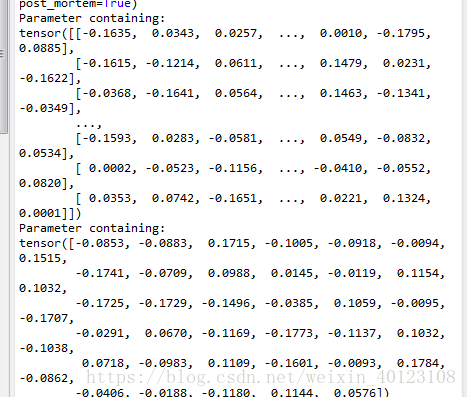pytorch入门之四参数初始化
pytorch之四参数初始化
# -*- coding: utf-8 -*-
"""
Created on Fri Jul 27 20:57:51 2018
@author: dj
"""
import numpy as np
import torch
from torch import nn
使用 NumPy 来初始化因为 PyTorch 是一个非常灵活的框架,理论上能够对所有的 Tensor 进行操作,所以我们能够通过定义新的 Tensor 来初始化,直接看下面的例子
定义一个 Sequential 模型
net1 = nn.Sequential(
nn.Linear(30, 40),
nn.ReLU(),
nn.Linear(40, 50),
nn.ReLU(),
nn.Linear(50, 10)
)
访问第一层的参数
w1 = net1[0].weight
b1 = net1[0].bias
print(w1)
print(b1)

注意,这是一个 Parameter,也就是一个特殊的 Variable,我们可以访问其 .data属性得到其中的数据,然后直接定义一个新的 Tensor 对其进行替换,我们可以使用 PyTorch 中的一些随机数据生成的方式,比如 torch.randn,如果要使用更多 PyTorch 中没有的随机化方式,可以使用 numpy
# 定义一个 Tensor 直接对其进行替换
net1[0].weight.data = torch.from_numpy(np.random.uniform(3, 5, size=(40, 30)))
print(net1[0].weight)

可以看到这个参数的值已经被改变了,也就是说已经被定义成了我们需要的初始化方式,如果模型中某一层需要我们手动去修改,那么我们可以直接用这种方式去访问,但是更多的时候是模型中相同类型的层都需要初始化成相同的方式,这个时候一种更高效的方式是使用循环去访问,比如
for layer in net1:
if isinstance(layer, nn.Linear): # 判断是否是线性层
param_shape = layer.weight.shape
layer.weight.data = torch.from_numpy(np.random.normal(0, 0.5, size=param_shape))
# 定义为均值为 0,方差为 0.5 的正态分布
"""
小练习:一种非常流行的初始化方式叫 Xavier,方法来源于 2010 年的一篇论文 Understanding the difficulty of training deep feedforward neural networks,其通过数学的推到,证明了这种初始化方式可以使得每一层的输出方差是尽可能相等的
,给出这种初始化的公式 w ∼ U n i f o r m [ − 6 n j + n j + 1 , 6 n j + n j + 1 ] w\ \sim \ Uniform[- \frac{\sqrt{6}}{\sqrt{n_j + n_{j+1}}}, \frac{\sqrt{6}}{\sqrt{n_j + n_{j+1}}}] w ∼ Uniform[−nj+nj+16,nj+nj+16]
其中 n j n_j nj 和 n j + 1 n_{j+1} nj+1 表示该层的输入和输出数目,所以请尝试实现以下这种初始化方式
对于 Module 的参数初始化,其实也非常简单,如果想对其中的某层进行初始化,可以直接像 Sequential 一样对其 Tensor 进行重新定义,其唯一不同的地方在于,如果要用循环的方式访问,需要介绍两个属性,children 和 modules,下面我们举例来说明
class sim_net(nn.Module):
def __init__(self):
super(sim_net, self).__init__()
self.l1 = nn.Sequential(
nn.Linear(30, 40),
nn.ReLU()
)
self.l1[0].weight.data = torch.randn(40, 30) # 直接对某一层初始化
self.l2 = nn.Sequential(
nn.Linear(40, 50),
nn.ReLU()
)
self.l3 = nn.Sequential(
nn.Linear(50, 10),
nn.ReLU()
)
def forward(self, x):
x = self.l1(x)
x =self.l2(x)
x = self.l3(x)
return x
net2 = sim_net()
访问 children
for i in net2.children():
print(i)
# 访问 modules
for i in net2.modules():
print(i)
children 只会访问到模型定义中的第一层,因为上面的模型中定义了三个Sequential,所以只会访问到三个 Sequential,而 modules 会访问到最后的结构比如上面的例子,modules 不仅访问到了 Sequential,也访问到了 Sequential 里面,这就对我们做初始化非常方便,比如
for layer in net2.modules():
if isinstance(layer, nn.Linear):
param_shape = layer.weight.shape
layer.weight.data = torch.from_numpy(np.random.normal(0, 0.5, size=param_shape))
from torch.nn import init
print(net1[0].weight)
init.xavier_uniform(net1[0].weight) # 这就是上面我们讲过的 Xavier 初始化方法,PyTorch 直接内置了其实现
print(net1[0].weight)
注:转载大神的GitHub ,https://github.com/L1aoXingyu/code-of-learn-deep-learning-with-pytorch